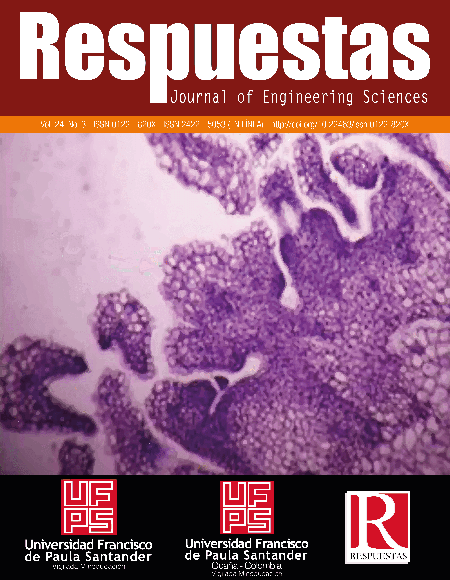Specific heat measurement of organic and conventional coffee samples by thermal relaxation
Medición del calor específico de muestras de café orgánico y convencional por relajación térmica
Main Article Content
The specific heat at constant pressure (Cp) is a necessary thermal parameter in the description of the heat transport in a material, related to the adaptation to changes of temperature, which is very important in the valuation and inspection of inputs for the construction, adhesives, insulators thermal and electronic devices. In this work, a thermal relaxation system with infrared thermometry was used to determine the Cp of green coffee beans, measuring the temperature of the material placed inside a vacuum chamber that reaches a pressure of 10-2 Torr. The sample was heated by radiation with laser light and the data was obtained by means of an acquisition card. The calibration of the system was made comparing the values obtained of Cp of Zinc, Tungsten, Titanium and Steel sheets with those reported and similarity was found. This method was used to measure the Cp of samples of organic and conventional coffee; these values were subjected to an analysis of variance and significant differences were found with a confidence level of 95 %. This technique could be used for the discrimination of organic coffee in the certification process.
Downloads
Article Details
NORA ARLEM LARA BERNAL, “Método De Calentamiento Transitorio Para La Caracterización Térmica De Sólidos,” 2013.
E. Marı́n, O. Delgado-Vasallo, and H. Valiente, “A temperature relaxation method for the measurement of the specific heat of solids at room temperature in student laboratories,” Am. J. Phys., vol. 71, no. 10, pp. 1032–1036, 2003.
L. A. Ratamero, N. Cella, and A. J. S. Neto, “An inverse problem for thermal diffusivity estimation with the photoacoustic spectroscopy,” J. Phys. Conf. Ser., vol. 135, no. 1, p. 012086, 2008.
S. B. Luo, W. L. Wang, J. Chang, Z. C. Xia, and B. Wei, “Specific heat capacity of liquid and solid Ni83.5Ti16.5eutectic alloy,” Chem. Phys. Lett., vol. 679, pp. 172–175, 2017.
A. Lara-Bernal, E. Marín, and A. Calderón, “Técnica de relajación térmica con excitación variable: Caso de la ‘rampa’ de intensidad,” vol. 20, no. 3, pp. 17–20, 2007.
289 S.S. Gonçalves, M.G. da Silva, M.S. Sthel, S.L. Cardoso, R.R. Sanchez, J.B. Rieumont y H. Vargas, Phys. Stat. Sol. (a) 187, “No Title.” 2001.
J. R. Satti, D. K. Das, and D. Ray, “Specific heat measurements of five different propylene glycol based nanofluids and development of a new correlation,” Int. J. Heat Mass Transf., 2016.
F. GORDILLO-DELGADO, D. F. VALENCIA-GRISALES, and J. PLAZAS-SALDAÑA, “USO DE LA TÉCNICA DE ALAMBRE CALIENTE PARA LA MEDICIÓN DE LA CONDUCTIVIDAD TÉRMICA DE INFUSIONES DE CAFÉ ORGÁNICO Y CONVENCIONAL,” Rev. la Fac. Ciencias Univ. Nac. Colomb. Sede Medellín, vol. 5, pp. 105–113, 2016.
N. Aguilar-Rivera, E. Houbron, E. Rustrian, and L. C. Reyes-Alvarado, “Papel amate de pulpa de café (Coffea arabica) (Residuo de beneficio humedo),” Ra Ximhai, vol. 10, no. 3, pp. 103–117, 2014.
G. Seidel and P. H. Keesom, “Specific Heat of Gallium and Zinc in the Norxrial and Suyerconducting States,” Phys. Rev., vol. 12, no. 4, pp. 1083–1088, 1958.
M. M. Yakunkin, “Mechanism of High-Temperature Heat Capacity of Tungsten : Study of Relaxation Processes,” vol. 46, no. 2, pp. 219–225, 2004.
J. M. González C., “Producción de peliculas de nitruro-titanio-aluminio- vanadio (TiALV)N variando la temperatura del sustrato por la tecnica PAPVD,” Universidad Nacional De Colombia, 2007.
F. Incropera and D. Dewitt, Fundamentos de transferencia de calor, Cuarta. Mexico, 1999.
A. P. Macías-Martínez and C. E. Riaño-luna, “Café orgánico: caracterización, torrefacción y enfriamiento,” Cenicafé, vol. 53, no. 4, pp. 281–292, 2002.







